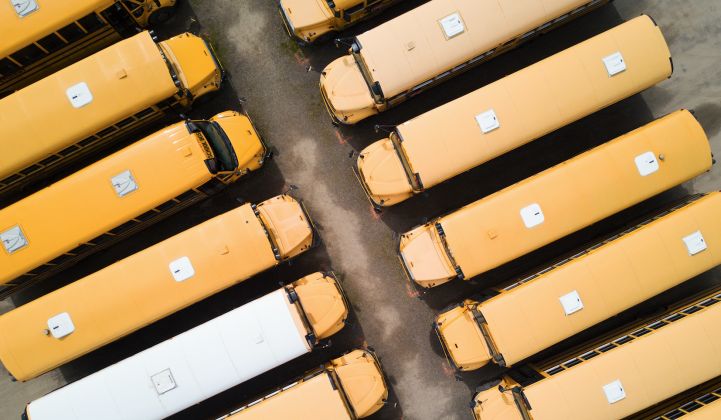School districts eager to replace polluting diesel buses can tap a suite of financial tools to overcome the additional upfront cost of electric buses, according to a new report.
Released last month by the U.S. Public Interest Research Group (PIRG) Education Fund and Environment America Research and Policy Center, the report emphasizes both the public health benefits of a diesel-for-electric bus swap and the availability of financing tools to enable school districts to make the switch.
The report calls on school districts to commit to transitioning to 100% all-electric bus fleets by 2030 and immediately phase out the purchase of diesel buses.
“It’s time to switch to electric school buses,” Matt Casale, report co-author and U.S. PIRG’s transportation campaign director, told Greentech Media in an interview. “Ninety-five percent of school buses in the United States still run on diesel. But we know there’s no safe level of exposure to diesel exhaust for children.”
He went on, “Every day, we’re putting them on these buses that are worsening asthma or worsening lung disease. We know that when they’re on the bus, when they’re getting on the buses, when they’re around the buses, when the buses are idling, they are exposed to high levels of diesel exhaust.”
Financing the electric school bus transition
Casale acknowledged the current higher upfront cost of electric school buses, but noted that on a life-cycle basis, electric school buses beat diesel buses on cost. His report found that electric school buses cost around $120,000 more than a comparable diesel bus at the time of purchase; however, a school district will pay $170,000 to $240,000 more in lifetime fuel and maintenance costs for the diesel model.
So how should cash-strapped school districts cover the cost of electric school buses? Casale said school districts can turn to the ballot and seek passage of traditional financing methods such as municipal bonds and local option transportation taxes.
He also highlighted the importance of state and federal incentive programs to pay down the upfront costs of electric school buses. Here, he added, California is the national leader with more than 150 electric school buses on the road and dedicated funding to replace diesel school buses.
According to the California Energy Commission, $94 million is available in the School Bus Replacement Program to swap diesel buses for electric models, with priority given to disadvantaged, low-income communities.
Several states — including Vermont, Minnesota, Arizona and Michigan — are also dedicating a portion of their shares of the Volkswagen diesel emission scandal financial settlement to new school buses, with some establishing carve-outs for electric models.
Michigan, for instance, will spend up to $3 million on all-electric school buses and charging infrastructure. Grants will cover up to 70 percent of the cost of the electric school bus and charging station.
In the future, Casale said, vehicle-to-grid (V2G) applications could unlock additional revenue streams for school districts. Idle during daytime peak hours, overnight, and over summer breaks, the battery packs in V2G-enabled electric school buses could be tapped to provide grid services or used by school districts for demand charge management and peak-shaving.
The Clinton Global Initiative recently led a demonstration project, supported by the California Energy Commission, South Coast Air Quality Management District, and NRG/EVgo, to deploy a total of six V2G-enabled school buses at three districts in California. The pilot found that each bus could generate $6,100 annually in V2G revenues.
Casale also advised school districts to engage with their utility to secure the most beneficial rate structure to accommodate charging and to seek investments in charging infrastructure.
Proterra and Thomas Built Buses unveil new electric school bus
Competition among manufacturers and production at scale should enable all-electric buses to reach initial cost parity with diesel buses.
Toward that end, a new model hit the market at the end of last month with the launch of an all-electric school bus from California-based electric bus maker Proterra and Daimler subsidiary Thomas Built Buses. The Saf-T-Liner eC2 bus is the first vehicle to emerge from a Proterra-Daimler collaboration on heavy-duty vehicle electrification announced in September.
Reached by email, Proterra spokesperson Alison Mickey said the company wasn’t ready to announce a timeframe for production or delivery of the new electric school bus or whether any orders had been placed by school districts.
Mickey also said Proterra was not ready to disclose if the new bus would be made available to school districts via lease. Proterra offers several leasing options for municipalities and transportation agencies to acquire all-electric transit buses.
Building the electric school bus market
It’s early days for the electric school bus market, said U.S. PIRG’s Casale. School districts are still weighing their options for adding cleaner buses, and, even with the entry of Proterra into the space, there are still just a handful of school bus manufacturers.
Nevertheless, Casale is confident that manufacturers can scale to meet increased demand.
“By the end of 2019, if everything that is in the works goes according to plan, all the major manufacturers will have an electric bus model,” he said. “The thing that is really going to drive the market is if school districts really get on board and start putting out [solicitations].”




